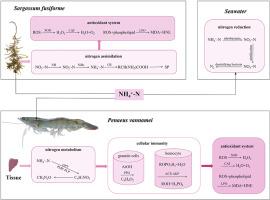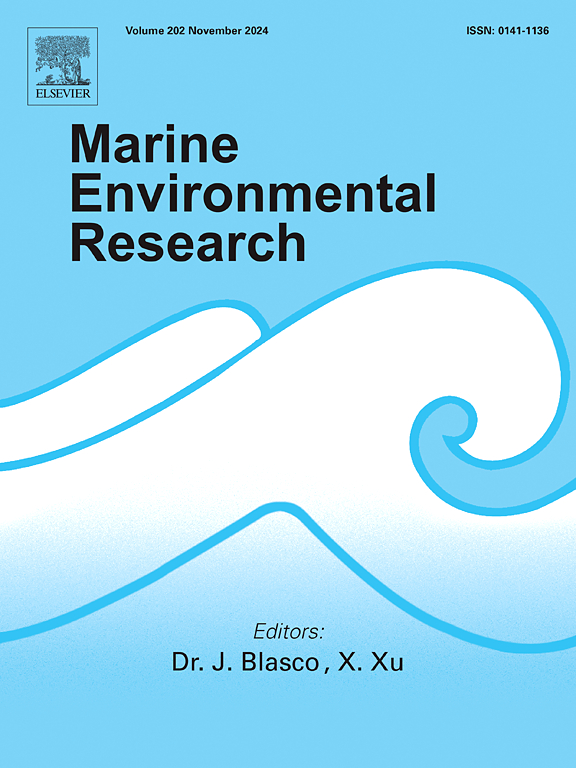Sargassum fusiforme improves the growth conditions of prawn by means of nutrient utilization and improvement of the microbial environment
IF 3.2
3区 环境科学与生态学
Q2 ENVIRONMENTAL SCIENCES
引用次数: 0
Abstract
The enrichment of inorganic nitrogen in the aquaculture water can contribute to aquatilia diseases and lead to seawater pollution. In this study, we explored the alleviating effect and mechanism of Sargassum fusiforme on ammonia poisoning in seawater during shrimp farming. The results revealed that in the early cultivation period, there was a 88.14 % elimination of NH4+-N, an inhibition of the exponential proliferation of microalgae. However, after 10 days of cultivation, there were increases in the richness and diversity of the bacterial communities in the water. Although there were initial increases in the photosynthesis of S. fusiforme, along with significant increases in the contents of soluble proteins and the activity of antioxidant enzymes, there were corresponding reductions in the nitrogen absorption capacity and relative growth rate. During the later stage of cultivation, P. vannamei was subjected to NH4+-N stress, which promoted the activities of antioxidant and immune-related enzymes; however, the period during which P. vannamei was subjected to NH4+-N stress was short, and the RGR of P. vannamei was 1.35 %, which was significantly higher than other aquaculture systems. This indicated that S. fusiforme can efficiently utilize ammonia, improve the growth environment of P. vannamei, and enhance its survival capacity by optimizing the microbial community relationship in the water. These findings provided reference and data support for the construction of high-density breeding and the ecological treatment of aquaculture wastewater for aquatic animals.

马尾藻通过营养物质的利用和微生物环境的改善改善对虾的生长条件
养殖水体中无机氮的富集会导致水产病害,导致海水污染。本研究探讨了马尾藻对对虾养殖过程中海水氨中毒的缓解作用及其机理。结果表明,在培养初期,NH4+-N的去除率为88.14%,抑制了微藻的指数增殖。然而,经过10天的培养,水中细菌群落的丰富度和多样性有所增加。虽然纺锤花光合作用在初始阶段有所增加,可溶性蛋白含量和抗氧化酶活性显著增加,但氮素吸收能力和相对生长速率却相应降低。在栽培后期,凡纳梅经受了NH4+-N胁迫,提高了抗氧化和免疫相关酶的活性;而凡纳滨对虾受NH4+-N胁迫的时间较短,RGR为1.35%,显著高于其他养殖系统。这说明梭形梭菌可以通过优化水体微生物群落关系,有效利用氨,改善凡纳滨虾的生长环境,提高其生存能力。本研究结果为水生动物高密度养殖的建设和养殖废水的生态处理提供了参考和数据支持。
本文章由计算机程序翻译,如有差异,请以英文原文为准。
求助全文
约1分钟内获得全文
求助全文
来源期刊

Marine environmental research
环境科学-毒理学
CiteScore
5.90
自引率
3.00%
发文量
217
审稿时长
46 days
期刊介绍:
Marine Environmental Research publishes original research papers on chemical, physical, and biological interactions in the oceans and coastal waters. The journal serves as a forum for new information on biology, chemistry, and toxicology and syntheses that advance understanding of marine environmental processes.
Submission of multidisciplinary studies is encouraged. Studies that utilize experimental approaches to clarify the roles of anthropogenic and natural causes of changes in marine ecosystems are especially welcome, as are those studies that represent new developments of a theoretical or conceptual aspect of marine science. All papers published in this journal are reviewed by qualified peers prior to acceptance and publication. Examples of topics considered to be appropriate for the journal include, but are not limited to, the following:
– The extent, persistence, and consequences of change and the recovery from such change in natural marine systems
– The biochemical, physiological, and ecological consequences of contaminants to marine organisms and ecosystems
– The biogeochemistry of naturally occurring and anthropogenic substances
– Models that describe and predict the above processes
– Monitoring studies, to the extent that their results provide new information on functional processes
– Methodological papers describing improved quantitative techniques for the marine sciences.
 求助内容:
求助内容: 应助结果提醒方式:
应助结果提醒方式:


